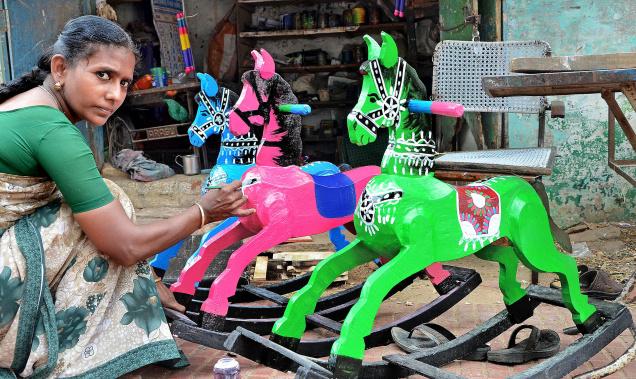
Pushpalatha and her husband have been crafting wooden rocking horses for 15 years
On the busy Moopanar Road opposite the head post office in Thanjavur, where the vehicular traffic roars up and down, making conversations difficult, J. Pushpalatha and her husband F. Joseph have been engaged in the craft of making rocking horses for the past 15 years.
An errant head carpenter who vanished with the money to buy mango wood for a big order angered Pushpalatha so much that she decided to learn the art herself. “My husband was initially afraid of losing business and supported the carpenter, but when he ran away, and I decided to try my hand at making the rocking horses myself, he started to help me,” says Pushpalatha, 49, who has done a certificate course in carpentry and upholstery.
The couple’s 10 feet by 20 feet shop has no electricity, and no room for anything else except the stock of mango wood planks used for creating these toys, but they are not complaining. “We spend Rs.3,300 on one rocking horse, but we sell it for Rs.1,300 only, as we’d like more children to be able to play with them,” says Pushpalatha. “This used to be a toy for children from rich families, but we are now supplying this, and the rocking swan, to schools as well.”
Joseph, a former administrative worker at the Khadi and Village Industries Commission, also helps out with procuring the materials.
Pushpalatha admits her first samples were rather disappointing. “But I picked up slowly through trial and error. It takes me a whole day to saw the different parts and assemble them, and around three days to paint the rocking horse,” she says. “We use seasoned mango wood because it’s the safest for children, and eucalyptus for the handles.”
Each piece is individually measured and fitted into notches.
Once the skeletal structure is nailed together, the entire toy is coated with ‘matti’ – a thick paste of chalk powder and plaster of Paris – and allowed to dry. A coating of red oxide follows next. This allows the toy’s sharper edges to be moulded.
The horse is then sandpapered and smoothened to remove any stray splinters. “Since this will be used by many children, we have to be very careful about each part, especially the seat area,” says Pushpalatha. The horses assume their final shape with their caparisons painted on in bright colours.
The toys, made in batches of 12, are available only at their humble premises (at an advance notice of 15 days) for now. “Many toy stores have approached us, but they want a higher price tag, which could hit business,” says Pushpalatha.
Except the basic planks that are machine-sawn at the mill, everything else is assembled by hand at the Moopanar Road workshop.
Pushpalatha and Joseph are proud to say that these toys helped them to put their son and daughter through college and become engineers. But they do worry about who will take over next. “We are ready to train anyone, but don’t have the facilities for it. If the government can provide artisans like us with a centre, we can easily conduct classes,” says Pushpalatha. “Otherwise this art will die.”
source: http://www.thehindu.com / The Hindu / Home> Features> MetroPlus / by Nahla Nainar / May 29th, 2015
How do we contact them..I need one
Would you be able to ship some of these rocking horses to South Africa?
What is the price for one?
Thank you!
Riette Nouwens
How to contact them?